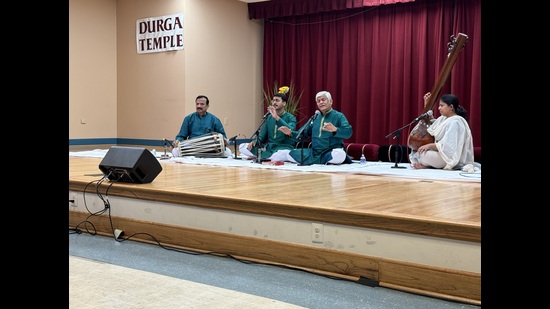A classical-folk jugalbandi in Virginia!
The unique fusion concert of Dhrupad and Rajasthani folk music had the American-Indian audience jumping up to sway to the irresistible beat
Dhrupad, a pristine form of Hindustani classical music that derives from the ancient Chhand-Prabandh Gayan offered compositional structure to the abstract raga. Swami Haridas and Tansen, the court musician of Emperor Akbar, and Raja Mansingh Tomar of Gwalior popularised it in the 15th and 16th centuries. This exalted position was retained till about the mid-19th century before Khayal singing took precedence with the patronage of Sultan Hussain Sharkie of Jaunpur and other royals, who preferred pleasing embellishments.

Primarily spiritual, Dhruva-Pada or Dhrupad is a combination of swar, taal, and pada. The swar-vistar (melodic elaboration) is done during the detailed alap and the laya-vistar (rhythmic elaborations) is done through the delineation of the pada. So, Drupad/Dhamar compositions have melody, proper diction and a variety of layakari in the given tala.
Historically associated with temples, Dhrupad compositions gave importance to the lyrical content with devotional padas addressed to the deity, or sung during religious festivals. The presentation style on the proscenium stage later focused on the creativity and ability of Dhrupad exponents to extemporise and improvise.

Dhrupad was introduced to the Western world by the Dagar Saptak, the seven brothers of the Dagar family practising the Dagur Bani (one among the four styles of Dhrupad singing namely Nauhar Bani, Khandhar Bani, Gobarhar Bani and Dagur Bani). They played a key role in popularising this ancient Indian musical form across the world in the 1970s. And so, Dhrupad travelled to the US as a serious and meditative genre of Indian classical music.
In India, it is believed that classical music emerged from folk music, which has umpteen varieties. The music of the Langa and Manganiar communities of Rajasthan is one such folk variant. These versatile singers and the instrumentalists accompanying them on the kamaicha (a string instrument like the sarbangi), and percussion instruments like the dholak and khartal, have also popularised Indian folk music abroad. Music flows in their families from father to son with even small children taking to singing or playing folk instruments from a tender age.
Despite the great energy that courses through both these streams, the classical and folk genres of Indian music have always been separate.
It, therefore, came as a pleasant surprise when the Gundecha Brothers, the famous Dhrupadiyas of the Dagar Gharana, performed with Anwar Khan, the award-winning Manganiar folk singer, and his group at the Durga Temple auditorium in Fairfax Station, Virginia, USA, on 22 September, 2024.
The Gundecha Brothers were trained under Ustad Ziya Mohiuddin Dagar and Ustad Ziya Fariduddin Dagar at the Dhrupad Kendra Bharat Bhavan, Bhopal. Apart from singing traditional Dhrupads, they have also sung the poetry of poets from Kabir to Nirala. This time, they conceived the idea of experimenting with an amalgamation of classical and folk music. They discussed it with Anwar Khan Manganiar and the result was a mesmerising duet of Dhrupad and the Rajasthani folk that was presented immediately after the individual performances of both sets of musicians.
First, Pandit Umakant Gundecha and Anant Gundecha, accompanied by Pandit Akhilesh Gundecha on pakhawaj and Dhani Gundecha on tanpura, opened with the detailed Dhrupad Aalapchari in raga Jog. They erected the imposing architecture of the raga from slow (vilambit) to medium (madhya) and fast tempo (drut laya), before presenting a traditional Tansen composition set to the Rudra taal of 11 beats. Saraswati, the goddess of learning, and Ganesha, the auspicious god of wisdom, were invoked through the lyrics, “Pratham Naad Saraswati, Ganapati Buddhidata…”
Next came the Durga Stuti in raga Durga sool-taal, “Aadi Shiva-Shakti”, which, of course, was in praise of the presiding deity of the temple venue. This was followed by the Kabir pada, “Jhini Jhini, Bini Chadariya” in raga Charukeshi. The Dhrupad segment concluded with a Shiva-Stuti, “Shankar Girija-Pati”, in raga Malkauns.

After the intermission, Anwar Khan Manganiar and his group comprising Ghevar Khan on kamaicha, Manzoor Khan on dholak and Gazi Khan on khartal showcased Rajasthan’s folk music. Opening with a Durga Stuti in a folk Ragini that resembled the Hindustani Madhmad Sarang, Anwar Khan’s vibrant voice, the earthy strains of the kamaicha, the rhythm of the dholak and the measured sound of the khartaal created a festive contrast to the contemplative Dhrupad.
The enchanting Maand, Kesariya Balam Aavo na Padharo Mhare Des, was full of warmth. Ram Ratan Dhan Payo was a soothing contrast with the komal swaras of raga Gunkali. After the sawal-jawab of the dholak and khartal in between the stanzas of the Meerabai pada came the concluding ghoomar, which inspired many of the women in the audience to get on the floor and dance.
The climax was a unique amalgam of Dhrupad and folk music. The Gundechas opened with a short aalap in raga Adana followed by the Dhrupad composition Shiva Shiva Shiva set to Drut Sool taal. Anwar Khan followed with a Shiva Stuti contrasted by the lilting gait of the Kaherwa theka on the dholak. There was no compromise with the purity or the spirit of the contrasting forms. While Dhrupad remained rich and contemplative, the folk music of the Manganiars maintained its vibrancy. Yet together, each enhanced the beauty of the whole musical experience.
While the foreign locale added some flavour to this fusion of Indian classical and folk music, it is certain that an even greater richness would emerge from more such collaborations in India too. Perhaps, a whole new musical chapter is set to begin.
Manjari Sinha is a senior music critic.
All Access.
One Subscription.
Get 360° coverage—from daily headlines
to 100 year archives.



HT App & Website






